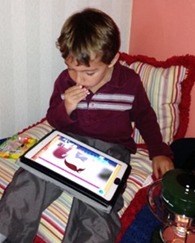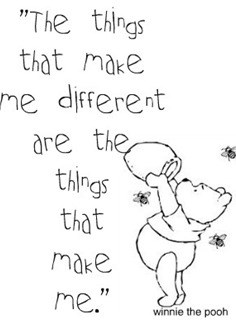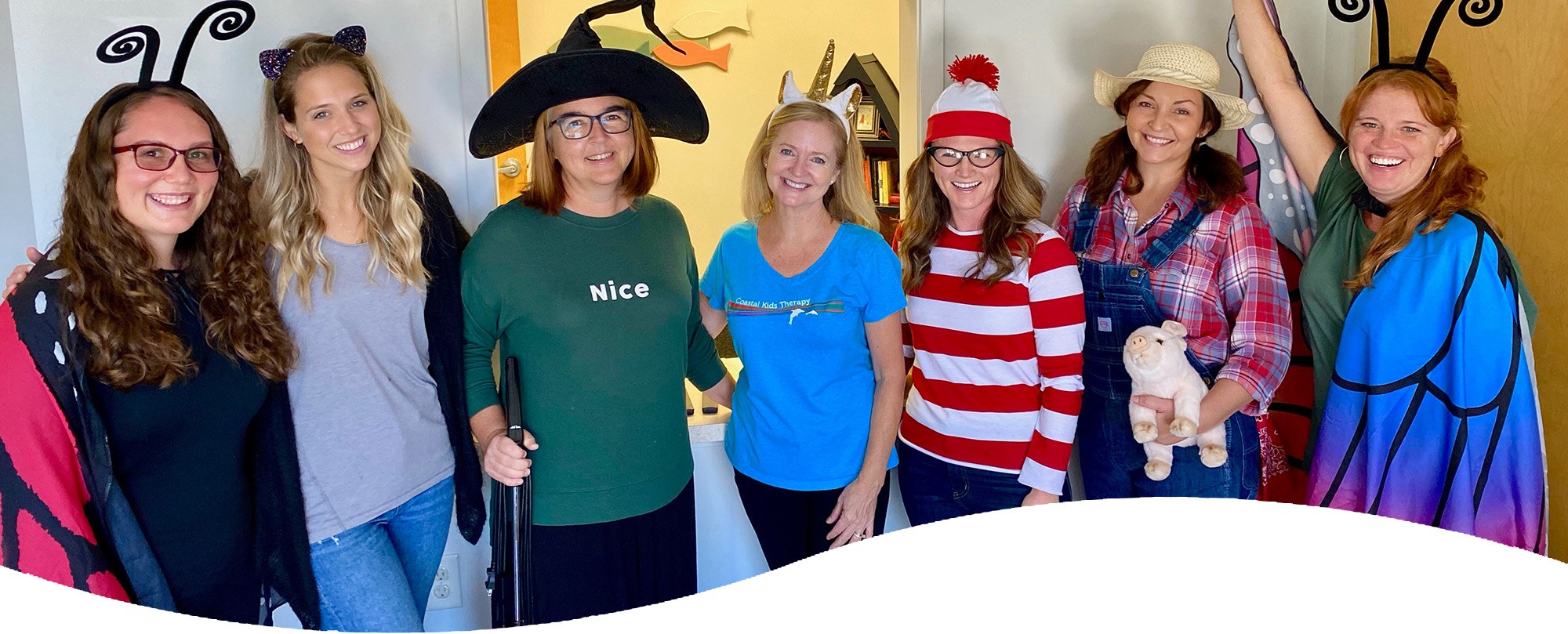Sensory Tips for Tigger
Laurel Thornton OTR/L
Sensory integration, sensory modulation, sensory regulation, sensory processing, sensory seeking, sensory avoiding! Many of you have heard these terms and maybe understand them. Many of you have never heard them. Many of you have heard them, have heard that your child has difficulty with them, but have no idea what this all means.
My favorite analogy comes from Gwen Wild's Brainworks program (www.sensationalbrain.com). Using the characters from A.A. Milne's beloved Winnie the Pooh, Gwen refers to the slow, low-affect donkey, Eeyore, to describe a person with low sensory registration; the bouncy, energetic tiger, Tigger, is the sensory seeker or person with high registration; and lovable Winnie the Pooh would best represent the person with just-right registration.
I suppose that would leave Christopher Robin as the therapist!
Let's start with Tigger, the sensory seeker, the over-responder. Tigger bounces around all day, very excited, impulsive, a thrill-seeker. While funny and fun-to-be with, Tigger might also be reckless, have decreased safety awareness, and at the end of the day is exhausting for his parents and teachers!
So what might we do to help Tigger be a little calmer, safer, and perhaps more "sensory regulated"?
A first step is to make adjustments to the environment. Natural light, classical or calming music, scheduled times of quiet (no television), vanilla and lavender scented candles, and reducing the visual clutter (use baskets and bins to help organize toys and belongings), and try rotating toys (only have a few toys out at a time and store the others out of sight). Avoid using fluorescent lights if at all possible. Set up a "cozy corner" with pillows and fidget toys/stress balls, headphones, and a few books.Rocking chairs, sitfit cushions, and exercise balls are helpful seating alternatives for the child who seeks movement and/or has difficulty staying seated during homework times. It is important to give the sensory seeking child movement breaks throughout the day. These can even be scheduled every 2 hours. This might include jumping on a mini trampoline, taking a walk or a run, playing basketball in the driveway, riding a bike, swinging, going to a park, or just free play outside.

Activities that provide heavy work are calming and organizing to the nervous system and can be very helpful for sensory regulation of the sensory seekers. This may include helping with chores such as vacuuming, taking out the trash, carrying in the groceries, mowing the grass and raking leaves.Chewing gum and sucking thick drinks (smoothies or milkshakes) through a straw can also be calming and organizing during homework time. Even drinking a warm drink such as hot chocolate can be calming.
Weighted blankets, weighted vests, and weighted lap pads are often helpful as they provide deep pressure which calms the nervous system. And remember when all else fails, giving a big bear hug (deep pressure), may be the very best sensory (and emotional) strategy of all.
The Occupations of a Child
From: “Meet the Expert” Wilmington Parent, July 2013 Issue.
Laurel Thornton, OTR/L
Joshua rises at 7:00 a.m. ready to start another busy day on the job. After taking care of his first “business” of the day, he heads to the kitchen for a healthy breakfast. He will need this for physical as well as mental nourishment as he has a busy agenda today.
After consulting with his faithful assistant (otherwise known as Mom) about today’s weather, Joshua dresses himself in the appropriate attire. With freshly brushed teeth and combed hair, he is feeling ready to seize the day. There are castles to build and canvases to paint, not to mention all of the letters, numbers, and shapes he will encounter.
At age 3, Joshua’s “occupations” are learning, playing, and self-care. He is building a foundation for future independence, socialization, and success in school and work.
These tasks come with minimal struggles for Joshua, but for many children that is not the case. Physical, cognitive, sensory, and developmental delays or difficulties make these daily “occupations” seem insurmountable. With the help of an occupational therapist who specializes in pediatrics, there is hope for all children.Occupational therapists hold bachelor’s, master’s, and sometimes doctorate degrees with extensive education in anatomy, kinesiology, neuroanatomy, child development, psychology, sensory systems, and task analysis.
In March of 2012, Coastal Kids Therapy, founded by sisters, Blair Kutrow and Laurel Thornton, opened its doors to help meet the need for pediatric occupational therapy services in Wilmington and surrounding areas. Blair and Laurel both relocated to Wilmington to fulfill Laurel’s dream of owning a pediatric occupational therapy practice. Their desire is to provide excellent therapy services in a cheerful, “home-like” environment that is child and parent friendly. With Blair’s 25 years of experience in executive leadership positions in Washington DC and Laurel’s 25 years of experience as a pediatric occupational therapist, they are achieving this dream.
In its first year since opening, Coastal Kids Therapy has grown quickly to meet the needs in the Wilmington, Jacksonville and surrounding counties, adding three therapists to their team. Weatherly Landry, an occupational therapy assistant, has brought amazing creativity, skills, and an upbeat positive attitude to the team. Occupational therapist, Colleen Rose recently joined the team when she moved to the area from Texas with her marine husband. Colleen’s knowledge, patience, and experience working with children especially those on the autism spectrum is a wonderful addition to Coastal Kids Therapy. Treating just a few afternoon children, Mandy Oestrich, another experienced occupational therapist has added yet more positive energy and expertise to the practice. The therapists at Coastal Kids Therapy provide thorough evaluations which focus on each child’s strengths as well as needs in the areas of motor skills, sensory processing, and self-care. The therapists at Coastal Kids Therapy have experience and expertise treating children with developmental delays, various genetic syndromes, including Down Syndrome, Cerebral Palsy, sensory processing disorders as well as children on the autism spectrum. Recognizing each child’s unique individuality while finding what motivates them is their key to creating a positive therapeutic environment.
Too Much, Too Little, Just Right
From: “Meet the Expert” Wilmington Parent, July 2012 Issue.
Laurel Thornton, OTR/L

“Nobody but a real princess could be that sensitive .” Thus goes the story of the Princess and the Pea. So sensitive was the real princess that a tiny pea under twenty mattresses kept her awake and miserable all night.
As a pediatric occupational therapist, I encounter many real life “princesses” who are so sensitive that typical everyday sensory stimulation results in internal and external distress.
Whether it’s the flickering of a fluorescent light, the humming of an air conditioner, the scratching of a clothing tag on the back of a neck, the mingling of smells in a school cafeteria, or a specific food texture, children with Sensory Processing Disorder (SPD) struggle through ordinary, daily life. Sometimes sensations are too much, other times too little, but rarely is the sensation “just right.
As a pediatric occupational therapist, I encounter many real life “princesses” who are so sensitive that typical everyday sensory stimulation results in internal and external distress. Whether it’s the flickering of a fluorescent light, the humming of an air conditioner, the scratching of a clothing tag on the back of a neck, the mingling of smells in a school cafeteria, or a specific food texture, children with Sensory Processing Disorder (SPD) struggle through ordinary, daily life. Sometimes sensations are too much, other times too little, but rarely is the sensation “just right.
”Sensory processing is the brain’s ability to receive information from the senses, interpret and organize that information, and produce a functional motor or behavioral response. Sensory Processing Disorder occurs when the brain misinterprets ordinary sensory information resulting in a negative behavior or motor response. Think of it as a traffic jam of the neurons and receptors in the brain. Although they are often intelligent, children with Sensory Processing Disorder frequently have difficulty with motor coordination, learning, and social skills. In many cases, they also struggle with low self-esteem.
Sensory Processing Disorder may cause children to be sensory seekers or sensory avoiders. Sensory seekers are the children who constantly wiggle, fidget, play too roughly, and can’t keep their hands to themselves. Sensory avoiders, on the other hand, are the children who are often so sensitive that normal sensations cause them great anxiety. These children may cover their ears at the sound of a vacuum cleaner or have a very limited diet due to an inability to tolerate different textures of foods.
Occupational therapists receive specialized training in the evaluation and treatment of SPD as well as many other special needs. Through careful evaluation, occupational therapists are able to analyze a child’s sensory profile and develop a treatment program of specifically selected sensory experiences that are challenging yet fun.
At Coastal Kids Therapy we provide state-of-the art occupational therapy in a warm and positive environment celebrating the individuality of each child while helping each to reach his or her full potential. We have over 20 years experience providing therapy for children with a wide range of sensory, motor, developmental, learning and behavioral difficulties. We provide a fun, playful and nurturing environment with much of the therapy taking place in our sensory-rich therapy gym. With a focus on sensory processing as the basis for all development, we develop programs focused on the specific needs of each child. For children with sensory processing disorders, we will develop a sensory diet of structured sensory experiences provided throughout the child’s day in appropriate and meaningful ways in order to help the child feel calm and alert. Whether the child with SPD is interpreting daily sensations as “too much” or whether their brain is registering “too little” sensation, the expertise of our occupational therapists can help the child regulate their sensory system and learn coping mechanisms so that they can ultimately feel “just right.”
"Building Confidence, a playful take on therapy."
From: WILMA Magazine, May 2015. By TERESA MCLAMB | photos by KATHERINE CLARK

Once a week a group of boys aged seven to ten meets near University of North Carolina Wilmington to talk and play games.
While playgroups aren’t unusual, the success of this group is worth noting. The boys are all developmentally challenged, and they’re all clients of COASTAL KIDS THERAPY, a practice that employs occupational therapy techniques to assist children with developmental needs.
Founded by occupational therapist LAUREL THORNTON, the center serves ninety local children. As for the boys’ group, she says they all struggle with friendships at school.
We felt it was important for them to make friends and have a place they feel safe and are able to flourish as the unique, wonderful kids that they are,” Thornton says. “We meet weekly with them and have a variety of activities with the focus on developing social skills and forming friendships. We also take them on outings once a month.
While in high school, Thornton became interested in children with special needs when she sat for a neighbor’s child who had cerebral palsy.
“The family had him in therapy, so he had some of the equipment I would come to use in my practice,” she says. “One of the books they had would later be one of my textbooks in school.”
Thornton moved to Wilmington after years of visiting her grandparents here. The East Carolina University grad had practiced occupational therapy in New Bern and Raleigh and had spent many years in the Wake and Cumberland county school systems.
Wilmington was always the place I thought I would retire,
she says.
As she and her sister, BLAIR KUTROW, approached age fifty, they discussed how they wanted to spend the next half of their lives. Moving to Wilmington jumped to the top of the list
Wilmington is a great place to live and a super great place to retire,
Thornton says. I love the beach and downtown; there’s so much to do here.
The two forged a plan that included Kutrow’s business management experience with Thornton’s therapy expertise. In March 2012, they took the leap and opened Coastal Kids Therapy on Racine Drive.
Thornton says occupational therapy is defined as
the use of assessment and treatment to develop, recover, or maintain the daily living skills of people with physical, mental, or cognitive challenges.
Children’s occupations are playing, learning, and self-care, she says.
Children with conditions such as cerebral palsy or autism or genetic syndromes such as Down syndrome can benefit from occupational therapy.
“We evaluate the visual motor, sensory motor, and fine motor skills of the child,” Thornton says. Then a plan is developed with input from the parents as to what goals are set so that the child can be as independent and successful as he or she can be. “The goals might be dressing skills, feeding skills, handwriting, or fine motor skills such as being able to play with toys, manage clothing fasteners, or hold a pencil,” she says.
Thornton says her office looks more like a playhouse than an office, with rocking chairs, swings, a trapeze, and an obstacle course. “Everything we do looks like play, and we try to find things that are super fun and motivating for the children,” she says. Activities might include squeezing clothespins to pick up objects on the floor. They might swing from a trapeze and pop bubbles with their feet, which results in strengthening of their arms, hands, and core muscles.
"Believe it or not, all of that has an impact on a skill set such as handwriting because they have to have the postural control to sit in a chair and hold their body up in order to use their hands correctly and have the strength to hold a pencil and the motor planning to form letters,” Thorton says.
Thornton’s patients range in age from four months to seventeen years. They are brought in by parents, referred by doctors, and forwarded by the state’s Children’s Developmental Services Agencies, which provide intervention for children from birth to three years who have developmental delays but may have no specific diagnosis.
“The earlier you get these services, the better,” Thornton says.
In addition to Thornton, Coastal Kids Therapy has three therapists. “We try to focus on what motivates the child and building the child’s self-confidence so that each time they leave their therapy session they feel they’ve achieved something, and they’re a little more confident,” she says. “I’m proud of the fact that we came here not knowing anyone other than our grandparents and had to build a reputation for ourselves,” Thornton says, adding that the office has worked with 300 children in the past three years. “It’s been a team effort. It’s been an amazing journey so far, and I can’t wait to see what the future holds for us.”





